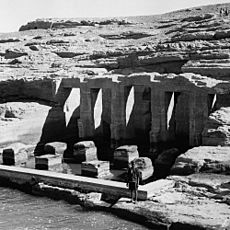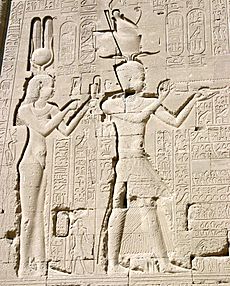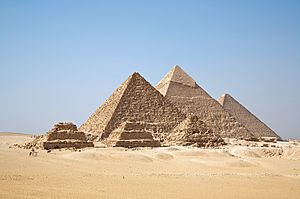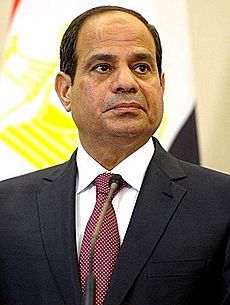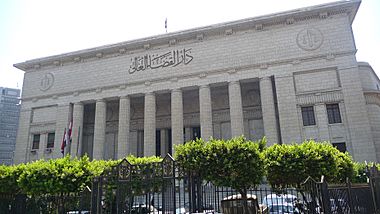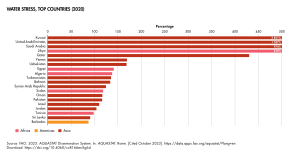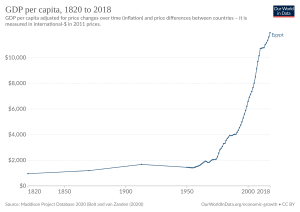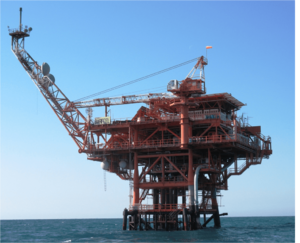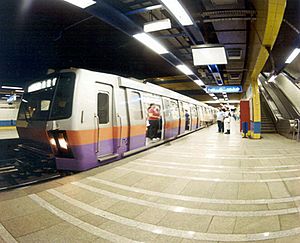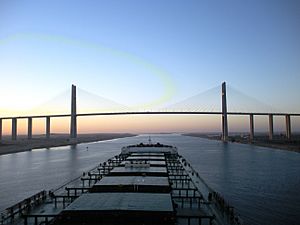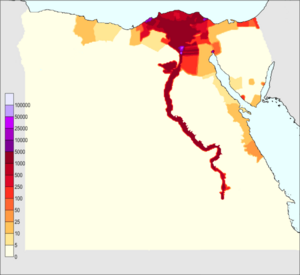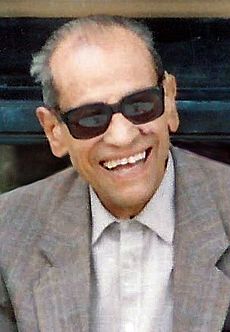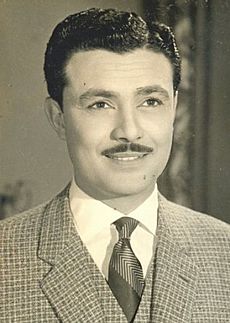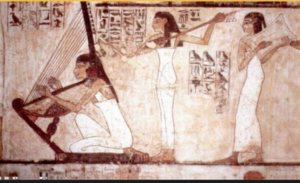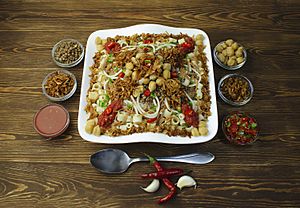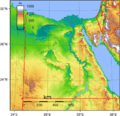Egypt facts for kids
Quick facts for kids
Arab Republic of Egypt
|
|
|---|---|
|
Anthem: "Bilady, Bilady, Bilady"
"بلادي، بلادي، بلادي" (English: "My country, my country, my country") |
|
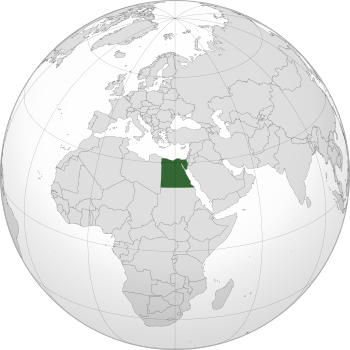 |
|
| Capital and largest city
|
Cairo 30°2′N 31°13′E / 30.033°N 31.217°E |
| Official languages | Arabic |
| National language | Egyptian Arabic |
| Religion | See Religion in Egypt |
| Demonym(s) | Egyptian |
| Government | Unitary semi-presidential republic under an authoritarian regime |
| Abdel Fattah el-Sisi | |
| Moustafa Madbouly | |
| Legislature | Parliament |
| Senate | |
| House of Representatives | |
| Establishment | |
|
• Unification of Upper
and Lower Egypt |
c. 3150 BC |
|
• Muhammad Ali dynasty inaugurated
|
9 July 1805 |
| 28 February 1922 | |
|
• Revolution Day
|
23 July 1952 |
|
• Republic declared
|
18 June 1953 |
|
• Current constitution
|
18 January 2014 |
| Area | |
|
• Total
|
1,010,408 km2 (390,121 sq mi) (29th) |
|
• Water (%)
|
0.632 |
| Population | |
|
• 2023 estimate
|
110,000,000 (15th) |
|
• 2017 census
|
94,798,827 |
|
• Density
|
103.56/km2 (268.2/sq mi) (118th) |
| GDP (PPP) | 2023 estimate |
|
• Total
|
|
|
• Per capita
|
|
| GDP (nominal) | 2023 estimate |
|
• Total
|
|
|
• Per capita
|
|
| Gini (2017) | ▼ 31.5 medium |
| HDI (2021) | high · 97th |
| Currency | Egyptian pound (LE/E£/£E) (EGP) |
| Time zone | UTC+2 (EGY) |
|
• Summer (DST)
|
UTC+3 |
| Driving side | right |
| Calling code | +20 |
| ISO 3166 code | EG |
| Internet TLD |
|
Egypt (Arabic: مصر Miṣr), officially the Arab Republic of Egypt, is a transcontinental country spanning the northeast corner of Africa and the Sinai Peninsula in the southwest corner of Asia.
Egypt is considered to be a regional power in North Africa, the Middle East and the Muslim world, and a middle power worldwide. Egypt is a founding member of the United Nations, the Non-Aligned Movement, the Arab League, the African Union, Organisation of Islamic Cooperation, World Youth Forum, and a member of BRICS.
Contents
History
Egypt has one of the longest histories of any country, tracing its heritage along the Nile Delta back to the 6th–4th millennia BCE. Considered a cradle of civilisation, Ancient Egypt saw some of the earliest developments of writing, agriculture, urbanisation, organised religion and central government. Egypt's long and rich cultural heritage is an integral part of its national identity, which reflects its unique transcontinental location being simultaneously Mediterranean, Middle Eastern and North African. Egypt was an early and important centre of Christianity, but was largely Islamised in the seventh century.
Modern Egypt dates back to 1922, when it gained independence from the British Empire as a monarchy. Following the 1952 revolution, Egypt declared itself a republic, and in 1958 it merged with Syria to form the United Arab Republic, which dissolved in 1961.
Throughout the second half of the 20th century, Egypt endured social and religious strife and political instability, fighting several armed conflicts with Israel in 1948, 1956, 1967 and 1973, and occupying the Gaza Strip intermittently until 1967. In 1978, Egypt signed the Camp David Accords, officially withdrawing from the Gaza Strip and recognising Israel. After the Arab Spring, which led to the 2011 Egyptian revolution and overthrow of Hosni Mubarak, the country faced a protracted period of political unrest; this included the election in 2012 of a brief, short-lived Muslim Brotherhood-aligned Islamist government spearheaded by Mohamed Morsi, and its subsequent overthrow after mass protests in 2013.
Name
The ancient Egyptian name of the country was
|
|
(𓆎 𓅓 𓏏𓊖) km.t, which means "black land", likely referring to the fertile black soils of the Nile flood plains, distinct from the deshret (⟨dšṛt⟩), or "red land" of the desert. This name is commonly vocalised as Kemet, but was probably pronounced in ancient Egyptian. Another name was ⟨tꜣ-mry⟩ "land of the riverbank".
Government
Egypt is a semi-presidential republic led by president Abdel Fattah el-Sisi since he was elected in 2014.
The House of Representatives, whose members are elected to serve five-year terms, specialises in legislation. Elections were held between November 2011 and January 2012, which were later dissolved.
Egypt has the oldest continuous parliamentary tradition in the Arab world. The first popular assembly was established in 1866. It was disbanded as a result of the British occupation of 1882, and the British allowed only a consultative body to sit. In 1923, however, after the country's independence was declared, a new constitution provided for a parliamentary monarchy.
Law
The legal system is based on Islamic and civil law (particularly Napoleonic codes); and judicial review by a Supreme Court, which accepts compulsory International Court of Justice jurisdiction only with reservations.
Location
Egypt is bordered by the Mediterranean Sea to the north, the Gaza Strip of Palestine and Israel to the northeast, the Red Sea to the east, Sudan to the south, and Libya to the west. The Gulf of Aqaba in the northeast separates Egypt from Jordan and Saudi Arabia.
Geography
Egypt lies primarily between latitudes 22° and 32°N, and longitudes 25° and 35°E. At 1,001,450 square kilometres (386,660 sq mi), it is the world's 30th-largest country. Due to the extreme aridity of Egypt's climate, population centres are concentrated along the narrow Nile Valley and Delta, meaning that about 99% of the population uses about 5.5% of the total land area. 98% of Egyptians live on 3% of the territory.
Egypt is bordered by Libya to the west, the Sudan to the south, and the Gaza Strip and Israel to the east. A transcontinental nation, it possesses a land bridge (the Isthmus of Suez) between Africa and Asia, traversed by a navigable waterway (the Suez Canal) that connects the Mediterranean Sea with the Indian Ocean by way of the Red Sea.
Apart from the Nile Valley, the majority of Egypt's landscape is desert, with a few oases scattered about. Winds create prolific sand dunes that peak at more than 30 metres (100 ft) high. Egypt includes parts of the Sahara desert and of the Libyan Desert.
Sinai peninsula hosts the highest mountain in Egypt, Mount Catherine at 2,642 meters. The Red Sea Riviera, on the east of the peninsula, is renowned for its wealth of coral reefs and marine life.
Climate
Most of Egypt's rain falls in the winter months. South of Cairo, rainfall averages only around 2 to 5 mm (0.1 to 0.2 in) per year and at intervals of many years. On a very thin strip of the northern coast the rainfall can be as high as 410 mm (16.1 in), mostly between October and March. Snow falls on Sinai's mountains and some of the north coastal cities such as Damietta, Baltim and Sidi Barrani, and rarely in Alexandria. A very small amount of snow fell on Cairo on 13 December 2013, the first time in many decades. Frost is also known in mid-Sinai and mid-Egypt.
Egypt has an unusually hot, sunny and dry climate. Average high temperatures are high in the north but very to extremely high in the rest of the country during summer. The cooler Mediterranean winds consistently blow over the northern sea coast, which helps to get more moderated temperatures, especially at the height of the summertime. The Khamaseen is a hot, dry wind that originates from the vast deserts in the south and blows in the spring or in the early summer. It brings scorching sand and dust particles, and usually brings daytime temperatures over 40 °C (104 °F) and sometimes over 50 °C (122 °F) in the interior, while the relative humidity can drop to 5% or even less.
Prior to the construction of the Aswan Dam, the Nile flooded annually, replenishing Egypt's soil. This gave Egypt a consistent harvest throughout the years.
The potential rise in sea levels due to global warming could threaten Egypt's densely populated coastal strip and have grave consequences for the country's economy, agriculture and industry. Combined with growing demographic pressures, a significant rise in sea levels could turn millions of Egyptians into environmental refugees by the end of the 21st century, according to some climate experts.
Biodiversity
Egypt signed the Rio Convention on Biological Diversity on 9 June 1992, and became a party to the convention on 2 June 1994. It has subsequently produced a National Biodiversity Strategy and Action Plan, which was received by the convention on 31 July 1998. Where many CBD National Biodiversity Strategy and Action Plans neglect biological kingdoms apart from animals and plants,
The plan stated that the following numbers of species of different groups had been recorded from Egypt: algae (1483 species), animals (about 15,000 species of which more than 10,000 were insects), fungi (more than 627 species), monera (319 species), plants (2426 species), protozoans (371 species). For some major groups, for example lichen-forming fungi and nematode worms, the number was not known. Apart from small and well-studied groups like amphibians, birds, fish, mammals and reptiles, the many of those numbers are likely to increase as further species are recorded from Egypt. For the fungi, including lichen-forming species, for example, subsequent work has shown that over 2200 species have been recorded from Egypt, and the final figure of all fungi actually occurring in the country is expected to be much higher. For the grasses, 284 native and naturalised species have been identified and recorded in Egypt.
Administrative divisions
Egypt is divided into 27 governorates. The governorates are further divided into regions. The regions contain towns and villages. Each governorate has a capital, sometimes carrying the same name as the governorate.
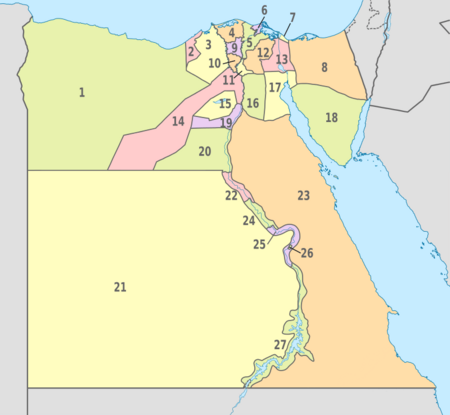
Largest cities
Cairo is the capital and largest city of Egypt, while Alexandria, the second-largest city, is an important industrial and tourist hub at the Mediterranean coast.
Largest cities
|
Largest cities or towns in Egypt
2017 census |
||
|---|---|---|
| Rank | Name | Pop. |
| 1 | Cairo | 9,153,135 |
| 2 | Alexandria | 5,039,975 |
| 3 | Giza | 4,146,340 |
| 4 | Shubra El Kheima | 1,165,914 |
| 5 | Port Said | 751,073 |
| 6 | Suez | 660,592 |
| 7 | Mansoura | 548,259 |
| 8 | El Mahalla El Kubra | 522,799 |
| 9 | Tanta | 508,754 |
| 10 | Faiyum | 475,139 |
Economy
It is a developing country having a diversified economy, which is the third-largest in Africa, the 38th-largest economy by nominal GDP and 127th by nominal GDP per capita.
Egypt's economy depends mainly on agriculture, media, petroleum exports, natural gas, and tourism. There are also more than three million Egyptians working abroad, mainly in Libya, Saudi Arabia, the Persian Gulf and Europe. The completion of the Aswan High Dam in 1970 and the resultant Lake Nasser have altered the time-honoured place of the Nile River in the agriculture and ecology of Egypt. A rapidly growing population, limited arable land, and dependence on the Nile all continue to overtax resources and stress the economy.
Tourism
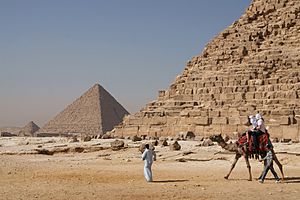
Tourism is one of the most important sectors in Egypt's economy. More than 12.8 million tourists visited Egypt in 2008, providing revenues of nearly $11 billion. The tourism sector employs about 12% of Egypt's workforce. Tourism Minister Hisham Zaazou told industry professionals and reporters that tourism generated some $9.4 billion in 2012, a slight increase over the $9 billion seen in 2011.
The Giza Necropolis is one of Egypt's best-known tourist attractions; it is the only one of the Seven Wonders of the Ancient World still in existence.
Egypt's beaches on the Mediterranean and the Red Sea, which extend to over 3,000 kilometres (1,900 miles), are also popular tourist destinations; the Gulf of Aqaba beaches, Safaga, Sharm el-Sheikh, Hurghada, Luxor, Dahab, Ras Sidr and Marsa Alam are popular sites.
Energy
Egypt has a developed energy market based on coal, oil, natural gas, and hydro power. Substantial coal deposits in the northeast Sinai are mined at the rate of about 600,000 tonnes (590,000 long tons; 660,000 short tons) per year. Oil and gas are produced in the western desert regions, the Gulf of Suez, and the Nile Delta. Egypt has huge reserves of gas, estimated at 2,180 cubic kilometres (520 cu mi), and LNG up to 2012 exported to many countries. In 2013, the Egyptian General Petroleum Co (EGPC) said the country will cut exports of natural gas and tell major industries to slow output this summer to avoid an energy crisis and stave off political unrest, Reuters has reported. Egypt is counting on top liquid natural gas (LNG) exporter Qatar to obtain additional gas volumes in summer, while encouraging factories to plan their annual maintenance for those months of peak demand, said EGPC chairman, Tarek El Barkatawy. Egypt produces its own energy, but has been a net oil importer since 2008 and is rapidly becoming a net importer of natural gas.
Egypt produced 691,000 bbl/d of oil and 2,141.05 Tcf of natural gas in 2013, making the country the largest non-OPEC producer of oil and the second-largest dry natural gas producer in Africa. In 2013, Egypt was the largest consumer of oil and natural gas in Africa, as more than 20% of total oil consumption and more than 40% of total dry natural gas consumption in Africa. Also, Egypt possesses the largest oil refinery capacity in Africa 726,000 bbl/d (in 2012).
Egypt is currently building its first nuclear power plant in El Dabaa, in the northern part of the country, with $25 billion in Russian financing.
Transport
Transport in Egypt is centred around Cairo and largely follows the pattern of settlement along the Nile. The main line of the nation's 40,800-kilometre (25,400 mi) railway network runs from Alexandria to Aswan and is operated by Egyptian National Railways. The vehicle road network has expanded rapidly to over 34,000 km (21,000 mi), consisting of 28 line, 796 stations, 1800 train covering the Nile Valley and Nile Delta, the Mediterranean and Red Sea coasts, the Sinai, and the Western oases.
The Cairo Metro consists of three operational lines with a fourth line expected in the future.
EgyptAir, which is now the country's flag carrier and largest airline, was founded in 1932 by Egyptian industrialist Talaat Harb, today owned by the Egyptian government. The airline is based at Cairo International Airport, its main hub, operating scheduled passenger and freight services to more than 75 destinations in the Middle East, Europe, Africa, Asia, and the Americas. The Current EgyptAir fleet includes 80 aeroplanes.
Suez Canal
The Suez Canal is an artificial sea-level waterway in Egypt, connecting the Mediterranean Sea and the Red Sea. Opened in November 1869 after 10 years of construction work, it allows ship transport between Europe and Asia without navigation around Africa. The northern terminus is Port Said and the southern terminus is Port Tawfiq at the city of Suez. Ismailia lies on its west bank, 3 kilometres (1+7⁄8 miles) from the half-way point.
The canal is 193.30 km (120+1⁄8 mi) long, 24 metres (79 feet) deep and 205 m (673 ft) wide as of 2010[update]. It consists of the northern access channel of 22 km (14 mi), the canal itself of 162.25 km (100+7⁄8 mi) and the southern access channel of 9 km (5+1⁄2 mi). The canal is a single lane with passing places in the Ballah By-Pass and the Great Bitter Lake. It contains no locks; seawater flows freely through the canal.
On 26 August 2014 a proposal was made for opening a New Suez Canal. Work on the New Suez Canal was completed in July 2015. The channel was officially inaugurated with a ceremony attended by foreign leaders and featuring military flyovers on 6 August 2015, in accordance with the budgets laid out for the project.
Population
At approximately 100 million inhabitants, Egypt is the 14th-most populated country in the world, and the third-most populated in Africa, behind Nigeria and Ethiopia. Egypt is the most populated country in the Arab world and is highly urbanised.
The great majority of its people live near the banks of the Nile River, an area of about 40,000 square kilometres (15,000 sq mi), where the only arable land is found. The large regions of the Sahara desert, which constitute most of Egypt's territory, are sparsely inhabited. About 43% of Egypt's residents live across the country's urban areas, with most spread across the densely populated centres of greater Cairo, Alexandria and other major cities in the Nile Delta.
Religion
Islam is the official religion of Egypt.
Languages
The official language of the Republic is Literary Arabic. The spoken languages are: Egyptian Arabic (68%), Sa'idi Arabic (29%), Eastern Egyptian Bedawi Arabic (1.6%), Sudanese Arabic (0.6%), Domari (0.3%), Nobiin (0.3%), Beja (0.1%), Siwi and others. Additionally, Greek, Armenian and Italian, and more recently, African languages like Amharic and Tigrigna are the main languages of immigrants.
The main foreign languages taught in schools, by order of popularity, are English, French, German and Italian.
Historically Egyptian was spoken, the latest stage of which is Coptic Egyptian. Spoken Coptic was mostly extinct by the 17th century but may have survived in isolated pockets in Upper Egypt as late as the 19th century. It remains in use as the liturgical language of the Coptic Orthodox Church of Alexandria. It forms a separate branch among the family of Afroasiatic languages.
Culture
Egypt is a recognised cultural trendsetter of the Arabic-speaking world. Contemporary Arabic and Middle-Eastern culture is heavily influenced by Egyptian literature, music, film and television. Egypt gained a regional leadership role during the 1950s and 1960s, giving a further enduring boost to the standing of Egyptian culture in the Arabic-speaking world.
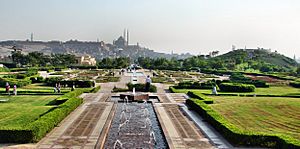
Egyptian identity evolved in the span of a long period of occupation to accommodate Islam, Christianity and Judaism; and a new language, Arabic, and its spoken descendant, Egyptian Arabic which is also based on many Ancient Egyptian words.
The work of early 19th century scholar Rifa'a al-Tahtawi renewed interest in Egyptian antiquity and exposed Egyptian society to Enlightenment principles. Tahtawi co-founded with education reformer Ali Mubarak a native Egyptology school that looked for inspiration to medieval Egyptian scholars, such as Suyuti and Maqrizi, who themselves studied the history, language and antiquities of Egypt.
Egypt's renaissance peaked in the late 19th and early 20th centuries through the work of people like Muhammad Abduh, Ahmed Lutfi el-Sayed, Muhammad Loutfi Goumah, Tawfiq el-Hakim, Louis Awad, Qasim Amin, Salama Moussa, Taha Hussein and Mahmoud Mokhtar. They forged a liberal path for Egypt expressed as a commitment to personal freedom, secularism and faith in science to bring progress.
Arts
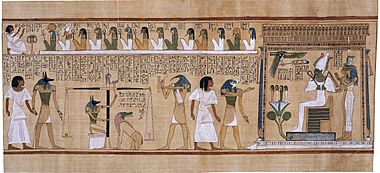
The Egyptians were one of the first major civilisations to codify design elements in art and architecture. Egyptian blue, also known as calcium copper silicate, is a pigment used by Egyptians for thousands of years. It is considered to be the first synthetic pigment. The wall paintings done in the service of the Pharaohs followed a rigid code of visual rules and meanings. Egyptian civilisation is renowned for its colossal pyramids, temples and monumental tombs.
Well-known examples are the Pyramid of Djoser designed by ancient architect and engineer Imhotep, the Sphinx, and the temple of Abu Simbel. Modern and contemporary Egyptian art can be as diverse as any works in the world art scene, from the vernacular architecture of Hassan Fathy and Ramses Wissa Wassef, to Mahmoud Mokhtar's sculptures, to the distinctive Coptic iconography of Isaac Fanous. The Cairo Opera House serves as the main performing arts venue in the Egyptian capital.
Literature
Egyptian literature traces its beginnings to ancient Egypt and is some of the earliest known literature. Indeed, the Egyptians were the first culture to develop literature as we know it today, that is, the book. It is an important cultural element in the life of Egypt. Egyptian novelists and poets were among the first to experiment with modern styles of Arabic literature, and the forms they developed have been widely imitated throughout the Arab world. The first modern Egyptian novel Zaynab by Muhammad Husayn Haykal was published in 1913 in the Egyptian vernacular. Egyptian novelist Naguib Mahfouz was the first Arabic-language writer to win the Nobel Prize in Literature. Egyptian women writers include Nawal El Saadawi, well known for her feminist activism, and Alifa Rifaat who also writes about women and tradition.
Vernacular poetry is perhaps the most popular literary genre among Egyptians, represented by the works of Ahmed Fouad Negm (Fagumi), Salah Jaheen and Abdel Rahman el-Abnudi.
Media
Egyptian media are highly influential throughout the Arab World, attributed to large audiences and increasing freedom from government control. Freedom of the media is guaranteed in the constitution; however, many laws still restrict this right.
Cinema
Egyptian cinema became a regional force with the coming of sound. In 1936, Studio Misr, financed by industrialist Talaat Harb, emerged as the leading Egyptian studio, a role the company retained for three decades. For over 100 years, more than 4000 films have been produced in Egypt, three quarters of the total Arab production. Egypt is considered the leading country in the field of cinema in the Arab world. Actors from all over the Arab world seek to appear in the Egyptian cinema for the sake of fame. The Cairo International Film Festival has been rated as one of 11 festivals with a top class rating worldwide by the International Federation of Film Producers' Associations.
The number of cinemas increased with the emergence of talking films, and reached 395 in 1958. This number began to decline after the establishment of television in 1960 and the establishment of the public sector in cinemas in 1962, and reached 297 in 1965, then to 141 in 1995 due to the circulation of films through video equipment though the boom of the film industry in this period. Due to laws and procedures that encouraged investment in the establishment of private cinemas, they increased again, especially in commercial centers, until their number reached 200 in 2001 and 400 in 2009. Over a period of more than a hundred years, Egyptian cinema has presented more than four thousand films.
Music
Egyptian music is a rich mixture of indigenous, Mediterranean, African and Western elements. It has been an integral part of Egyptian culture since antiquity. The ancient Egyptians credited one of their gods Hathor with the invention of music, which Osiris in turn used as part of his effort to civilise the world. Egyptians used music instruments since then.
Contemporary Egyptian music traces its beginnings to the creative work of people such as Abdu al-Hamuli, Almaz and Mahmoud Osman, who influenced the later work of Sayed Darwish, Umm Kulthum, Mohammed Abdel Wahab and Abdel Halim Hafez. Prominent contemporary Egyptian pop singers include Amr Diab and Mohamed Mounir.
Dances
Today, Egypt is often considered the home of belly dance. Egyptian belly dance has two main styles – raqs baladi and raqs sharqi. There are also numerous folkloric and character dances that may be part of an Egyptian-style belly dancer's repertoire, as well as the modern shaabi street dance which shares some elements with raqs baladi.
Museums
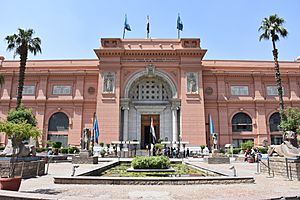
Egypt has one of the oldest civilisations in the world. It has been in contact with many other civilisations and nations and has been through so many eras, starting from prehistoric age to the modern age, passing through so many ages such as Pharonic, Roman, Greek, Islamic and many other ages. At least 60 museums may be found in Egypt.
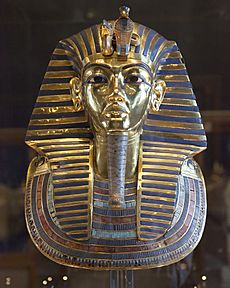
The three main museums in Egypt are The Egyptian Museum which has more than 120,000 items, the Egyptian National Military Museum and the 6th of October Panorama.
The Grand Egyptian Museum (GEM), also known as the Giza Museum, is an under construction museum that will house the largest collection of ancient Egyptian artifacts in the world, it has been described as the world's largest archaeological museum. The museum was scheduled to open in 2015 and will be sited on 50 hectares (120 acres) of land approximately two kilometres (1.2 miles) from the Giza Necropolis and is part of a new master plan for the plateau. The Minister of Antiquities Mamdouh al-Damaty announced in May 2015 that the museum will be partially opened in May 2018.
Festivals
Egypt celebrates many festivals and religious carnivals, also known as mulid. They are usually associated with a particular Coptic or Sufi saint, but are often celebrated by Egyptians irrespective of creed or religion.
The ancient spring festival of Sham en Nisim (Coptic: Ϭⲱⲙ‘ⲛⲛⲓⲥⲓⲙ shom en nisim) has been celebrated by Egyptians for thousands of years, typically between the Egyptian months of Paremoude (April) and Pashons (May), following Easter Sunday.
Cuisine
Egyptian cuisine relies heavily on legume and vegetable dishes. Although food in Alexandria and the coast of Egypt tends to use a great deal of fish and other seafood, for the most part Egyptian cuisine is based on foods that grow out of the ground. Meat has been very expensive for most Egyptians throughout history, so a great number of vegetarian dishes have been developed.
Some consider kushari (a mixture of rice, lentils, and macaroni) to be the national dish. In addition, ful medames (mashed fava beans) is one of the most popular dishes. Fava bean is also used in making falafel (also known as "ta'miya"), which may have originated in Egypt and spread to other parts of the Middle East. Garlic fried with coriander is added to molokhiya, a popular green soup made from finely chopped jute leaves, sometimes with chicken or rabbit.
Sports
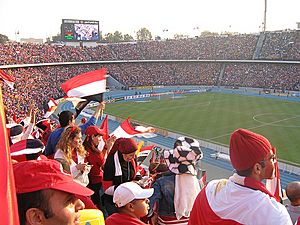
Football is the most popular national sport of Egypt. The Cairo Derby is one of the fiercest derbies in Africa, and the BBC picked it as one of the 7 toughest derbies in the world. Al Ahly is the most successful club of the 20th century in the African continent according to CAF, closely followed by their rivals Zamalek SC. They are known as the "African Club of the Century". With twenty titles, Al Ahly is currently the world's most successful club in terms of international trophies, surpassing Italy's A.C. Milan and Argentina's Boca Juniors, both having eighteen.
The Egyptian national football team, known as the Pharaohs, won the African Cup of Nations seven times, including three times in a row in 2006, 2008, and 2010. Considered the most successful African national team and one which has reached the top 10 of the FIFA world rankings, Egypt has qualified for the FIFA World Cup three times. Two goals from star player Mohamed Salah in their last qualifying game took Egypt through to the 2018 FIFA World Cup. The Egyptian Youth National team Young Pharaohs won the Bronze Medal of the 2001 FIFA youth world cup in Argentina. Egypt was 4th place in the football tournament in the 1928 and the 1964 Olympics.
Squash and tennis are other popular sports in Egypt. The Egyptian squash team has been competitive in international championships since the 1930s. Amr Shabana, Ali Farag and Ramy Ashour are Egypt's best players and all were ranked the world's number one squash player. Egypt has won the Squash World Championships five times, with the last title being in 2019.
In 1999, Egypt hosted the IHF World Men's Handball Championship, and hosted it again in 2021. In 2001, the national handball team achieved its best result in the tournament by reaching fourth place. Egypt has won in the African Men's Handball Championship five times, being the best team in Africa. In addition to that, it also championed the Mediterranean Games in 2013, the Beach Handball World Championships in 2004 and the Summer Youth Olympics in 2010. Among all African nations, the Egypt national basketball team holds the record for best performance at the Basketball World Cup and at the Summer Olympics. Further, the team has won a record number of 16 medals at the African Championship.
Egypt has taken part in the Summer Olympic Games since 1912 and has hosted several other international competitions including the first Mediterranean Games in 1951, the 1991 All-Africa Games, the 2009 FIFA U-20 World Cup and the 1953, 1965 and 2007 editions of the Pan Arab Games.
Egypt featured a national team in beach volleyball that competed at the 2018–2020 CAVB Beach Volleyball Continental Cup in both the women's and the men's section.
National symbols
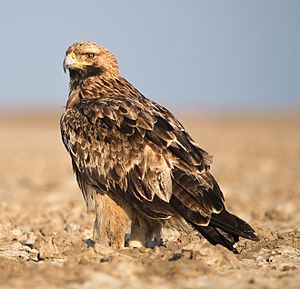
- The Eastern Imperial Eagle is the national animal of Egypt.
- The Egyptian lotus is the national flower of Egypt.
- The Doum palm (Hyphaene thebaica) is the natiobal tree.
National flag
The national flag of Egypt (علم مصر) is a tricolour consisting of the three equal horizontal red, white, and black bands of the Egyptian revolutionary flag dating back to the 1952 Egyptian Revolution. The flag bears Egypt's national emblem, the Egyptian eagle of Saladin centered in the white band.
The red band symbolizes the Egyptians’ blood in the war against colonization. The white band symbolizes the purity of the Egyptians’ heart. The black band below the white, symbolizes the manner in which darkness is overcome.
The same horizontal tricolour is used by Iraq, Syria, Sudan, and Yemen (and formerly Libya), the only difference being the presence (or absence) of distinguishing national emblems in the white band.
Images for kids
See also
 In Spanish: Egipto para niños
In Spanish: Egipto para niños
- Outline of ancient Egypt
- Outline of Egypt




